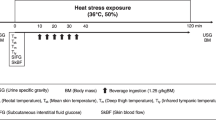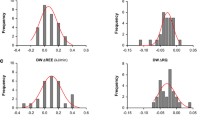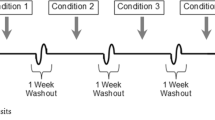Summary
When the loss of body heat is accelerated by exposure to low environmental temperatures, additional substrates must be oxidized to provide energy to sustain temperature homeostasis. Therefore, the present investigation examined the relation between feeding regime [pre-experimental carbohydrate feeding (FED) vs a fast (FAST)], during 120 min of exposure to 8, 20, and 27° C in well-nourished men. The following were examined: tissue insulation (I; °C · m2 · W−1), rectal temperature (T re; °C), and oxygen consumption (\(\dot V\)O2; ml · kg−1 · min−1). \(\dot V\)O2, T re, and I revealed no significant differences between treatments (FED vs FAST) at any temperature. At 27° C, I was less (P < 0.05) than at 20 and 8° C, and decreased (P < 0.05) as exposure time increased. At 8° C, \(\dot V\)O2was higher (P < 0.5) than at 20 or 27°C, and \(\dot V\)O2increased as time increased (P < 0.05). T re decreased (P < 0.05) as time increased for all conditions. Respiratory exchange ratio (R) differed (P < 0.05) between treatments (FED vs FAST), temperature (8 vs 20° C), and across time. Values for R suggests that carbohydrate accounted for 56% and 33% of caloric utilization during the FED vs FAST conditions, respectively. At 8 vs 20° C, R represented 54% vs 30% of cabohydrate utilization. Across time, R demonstrated that in both conditions (FED vs FAST) there was a decreased reliance on carbohydrate utilization for energy provision. From these data it appears that while substrate utilization differed between dietary treatment and across time this did not differentially affect \(\dot V\)O2or T re during protracted exposure to 8, 20, and 27° C. The higher R in the 8° C condition for both dietary treatments demonstrates that carbohydrate utilization is increased in shivering cold-exposed humans. However, the reduction in R across time suggests that fat oxidation is also involved in metabolic heat production and core temperature maintenance during shivering in the cold.
Similar content being viewed by others
References
Alexander G (1979) Cold thermogenesis. In: Robertshaw D (ed) International review of physiology. Environmental physiology III, vol 20. University Park Press, Baltimore, pp 43–155
Buskirk ER, Thompson RH, Wegdon GD (1963) Metabolic response to cold air in men and women in relation to total body fat content. J Appl Physiol 18:603–612
DuBois D, DuBois EF (1915) A formula to estimate the approximate surface area if height and weight be known. Arch Intern Med 17:863
Glickman-Weiss EL, Goss FL, Robertson RJ, Metz KF, Cassinelli DA (1991) Physiological and thermal responses of males with varying body compositions during immersion in moderately cold water. Aviat Space Environ Med 62:1063–1067
Himms-Hagen J (1972) Lipid metabolism during cold exposure and cold acclimation. Lipids 7:310–320
Jansson E (1982) On the significance of the respiratory exchange ratio after different diets during exercise in man. Acta Physiol Scand 114:103–110
Keatinge WR (1960) The effects of subcutaneous fat and of previous exposure to cold on the body temperature, peripheral blood flow, and metabolic rate of men in cold water. J Physiol (Lond) 143:166–178
Keeton RW, Lambert EH, Glickman N, Mitchell HH, Last JH, Fahnestock MK (1946) The tolerance of man to cold as affected by dietary modifications: proteins versus carbohydrates, and the effect of variable protective clothing. Am J Physiol 146:67–83
Lusk G (1928) The elements of the science of nutrition. Saunders, Philadelphia, pp 64–67
Mazzes RB, Barden HS, Bisek JP, Hanson J (1990) Dual-energy x-ray absorptiometry for total-body and regional bone-mineral and soft-tissue composition. Am J Clin Nutr 51:1106–12
McArdle WD, Magel JR, Gergley TJ, Spina RJ, Toner MM (1984) Thermal adjustment to cold water exposure to resting men and women. J Appl Physiol 56:1565–1571
Moore TO, Bernauer EM, Seto G, Park YS, Hong SK, Hayashi EM (1970) Effect of immersion at different water temperatures on graded exercise performance in man. Aerosp Med 41:1404–1408
Nadel ER, Holmes I, Bergh A, Astrand P-O, Stolwijk AJ (1974) Energy exchange of swimming men. J Appl Physiol 36:465–471
Pendergast DR (1988) The effect of body cooling on oxygen transport during exercise. Med Sci Sports Exerc 20: S171-S176
Rennie DW, Cavino BG, Howell BJ, Hong SH, Kang BS, Hong SK (1962) Physical insulation of Korean diving women. J Appl Physiol 17:961–966
Sink KR, Thomas TR, Araujo J, Hill SF (1989) Fat energy use and plasma lipid changes associated with exercise intensity and temperature. Eur J Appl Physiol 58:508–513
Swift RW (1932) The effects of low environmental temperature upon metabolism. Nutrition 5:213
Thompson GE (1977) Physiological effects of cold exposure. In: Robertshaw D (ed) International review of physiology II, vol 15. University Press, Baltimore, pp 29–69
Timmons BA, Araujo J, Thomas TR (1985) Fat utilization enhanced by exercise in a cold environment. Med Sci Sports Exerc 17:673–678
Toner MN, McArdle WD (1988) Physiological adjustments of man in the cold. In: Pandolf KB, Sawaka MN, Gonzalez RR (eds) Human performance physiology and environmental medicine at terrestrial extremes. Benchmark, Indianapolis, pp 361–399
Toner MM, Sawka MN, Foley ME, Pandolf KB (1986) Effects of body mass and morphology on thermal responses in water. J Appl Physiol 60:521–525
Vallerand AL, Jacobs I (1989) Rates of energy substrates utilization during human cold exposure. Eur J Appl Physiol 58:873–878
Vallerand AL, Perusse F, Bukowiecki LJ (1987) Cold exposure potentiates the effect of insulin on in vivo glucose uptake. Am J Physiol 253: E 179-E 186
Veicsteinas A, Ferretti G, Rennie DW (1982) Superficial shell insulation in resting and exercising men in cold water. J Appl Physiol 52:1557–1564
Young AJ, Sawka MN, Neufer PD, Muza SR, Askew EW, Pandolf KB (1989) Thermoregulation during cold water immersion is unimpaired by low muscle glycogen levels. J Appl Physiol 66:1809–1818
Author information
Authors and Affiliations
Rights and permissions
About this article
Cite this article
Glickman-Weiss, E.L., Nelson, A.G., Hearon, C.M. et al. Does feeding regime affect physiologic and thermal responses during exposure to 8, 20, and 27° C?. Europ. J. Appl. Physiol. 67, 30–34 (1993). https://doi.org/10.1007/BF00377700
Accepted:
Issue Date:
DOI: https://doi.org/10.1007/BF00377700




